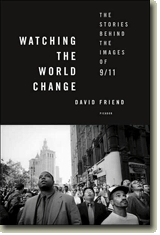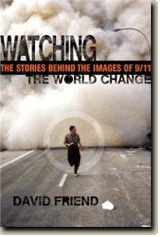« Previous · Home · Next »
September 30, 2006
AT THE FRONTIER
On September 11, 2001, Carmen Taylor, an Arkansas tourist, was standing in line to board the State Island Ferry. People murmured in the crowd upon hearing an explosion and then seeing smoke rising from the north tower of the World Trade Center. Several minutes later, at 9:03 a.m.,Taylor trained her digital camera on what she believed to be a military aircraft sweeping across the sky and took one of the most stunning images of 9/11: the second hijacked plane, photographed dead-on from the perspective of its tail section, left wing tilted upward, just as it collided with the south tower. Her picture would soon run in newspapers and on Web sites all over the world.
As a way of educating people back home in Arkansas about the lasting impact of that day, Taylor, in the summer of 2006, organized a photo exhibition at the University of Arkansas in Fort Smith, soliciting images from two dozen photographers. The show was the most popular in the institution's history. For the closing week, she invited me to speak to the students at U of A and to attend two book signings in her hometown, snug up against the Oklahoma border.
This is certainly the frontier. The famous town gallows, graced with a spanking coat of white paint, still sits near the banks of the Arkansas River. Down near the abandoned warehouses, stands Miss Laura's -- actually Belle Starr's legendary house of ill repute (now spruced up a toursist attraction, adorned with festive Christmas lights). There are tractors and river barges, the O.K. Feed Mill and D & D Gun & Pawn Shop. Several times yesterday, companions referred to the ranch and farmlands to the west as the old Indian terrirtories. The local daily, the Times Record, has an eight-page Religion section, replete with notices for an upcoming Pet Blessing at Trinity Episcopal ("all pets must be on a leash, in a cage or secured"), quotations from the Scripture (Galations 5:15: "You shall love your neighor as your own self"), a lead feature on Bible-themed video games, and a two-page spread entitled "Fort Smith & River Valley Guide to Area Churches," listing the times of worship at 308 Christian houses of prayer, 70 non-denominational churches, and one synagogue. I got a Cook's Tour from the university's jack-of-all-trades and arts coordinator Stacey Jones and from local journalists Linda Seubold and Lynn Wasson -- along with a warm welcome from the ebullient mayor, Ray Baker, who sang the town anthem ("Life's worth livin' in Fort Smith, Arkansas"), proclaimed this weekend "David Friend Days," and handed me the key to the city.
At the university's book signing, Tammy Malone bought two copies of Watching the World Change -- one for each of her daughters, Caitlyn, 6, and Carly, 3, "for when they grow up, for history's sake." (Five mothers at various signings have done the same, asking me to inscribe the book to their children so that in years to come they can share the narrative and lessons of September 11.) Chuck Booker, who had served 21 years as a bandmaster in the U.S. Army, bought a copy to send off to his son Erik, 34, of the First Infantry -- now in Kuwait, about to begin his second tour in Iraq.
Later in the day, during a slide show of images from the book, I looked out into the audience to see a woman wiping away tears. Another woman approached me, visibly upset, and opened the book to a news photo of a single man plummetting head-first to his death. "Why did you have to put this in there?" she asked, almost shaking. I could only explain that very few pictures of that day showed death up close and that this image forced us to confront that raw reality so that, five years on, we would remember the brutality and wouldn't allow ourselves to forget or become complacent. (The image, taken by Richard Drew of the Associated Press, is described at length in the book, on pages 135-141.)
Bookstore director Rodney Wallace walked over and opened a photo album emblazoned with a brown-and-green cover showing mallards in marshes. Inside, amid pictures of his children, he kept a snapshot taken from the top of the Empire State Building in 1993. On his first-ever trip to New York, he had been photographing at the very moment the World Trade Center was first attacked by al-Qaeda operatives. "I was scared," he recalled. "You didn't know what was happening. The fire and smoke started spreading." Eight years later, on 9/11, he explained, he had just received a shot for a migraine headache that morning, when he saw the televised sequence of the second plane's assault. "My wife said, 'This is the start of World War III' and I got this thing of despair. I felt sick. I started throwing up." By now he had closed his photo album. I nodded in response, commiserated, and understood how the events of September 11 still had the power to shake people all across the nation.
In the evening, another man, who will remain anonymous, shared a different view. "There are a lot of 'Good Ol' Boys' out here, with their camouflage ballcaps," he confided. "A lot of 'em. I know them. They don't think about nine-eleven. It didn't effect them. It didn't happen here. They don't ever think about New York." What about the bombings in Oklahoma City?, I asked, realizing the city's proximity to Fort Smith. "A lot of them agreed with [the bombers]. They thought government had it coming." What about the children in the day-care centers who died? "They had it coming to 'em, that's what they think. They have their [shotguns] -- it's only recently we had to take them down from the gun racks [on our trucks and vans]. They have their land. And that's it. You come after them, they'll use 'em."
Despite this chilly nightcap, the outpouring of warmth I had felt throughout this crisp September day was quite moving, heartening, sincere. I realized: I might have been given the key to the city, but there was a lot of Fort Smith that would remain safely locked away.


